Re-education at Camp Chaparral
Air Date: Week of May 2, 2008
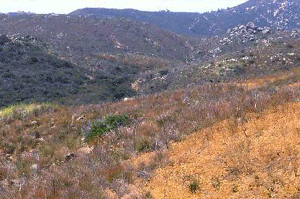
Chaparral being type-converted to weedy, non-native grassland in San Diego County. (Photo: Richard W. Halsey)
When you go into a national forest, you expect to see trees, but in southern California the forests are covered with shrubby plants known as chaparral. Living on Earth’s Ingrid Lobet visits San Bernardino National Forest and talks with scientists who are trying to protect the dry vegetation.
Transcript
GELLERMAN: The first wildfires of the season have already broken out in California, turning about 250 acres of National Forest there to a crisp. But it wasn’t giant redwoods or sequoias that went up in smoke – it was a family of shrubs known as chaparral.
Chaparral covers most of Southern California’s four national forests, and scientists say in some areas it’s in peril. Living on Earth's Ingrid Lobet visited the San Bernardino National Forest and has our story.
[FOOTSTEPS COME TO A STOP]
BORCHERT: What we're looking at are California sagebrush, and it creates this really quite pretty blueish-gray cast over the landscape.
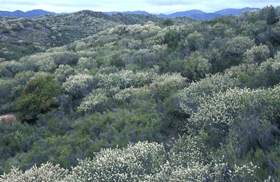
Ceanothus chaparral in the Trabuco Ranger District of the Cleveland National (Chaparral) Forest. (Photo: Richard W. Halsey)
BORCHERT: I want you to smell that. So that’s Artemisia, and so that’s the aromatic oils…
LOBET: The intoxicating scent of crushed California Sagebrush, or Artemisia, fills the air. But this little gray blue sagebrush stands apart now in a sea of bright green grasses.
[SOUND OF WET PLANT]
LOBET: These grasses arc across the face of the mountain and look fat and happy. Hugh Safford is lead ecologist for the Forest Service in California. He and Borchert survey the grass-covered mountainside.
SAFFORD: I mean, basically every species that we can touch right here is from somewhere in Central Asia or North Africa or Southern Europe.
Yeah, essentially what you’ve done is you’ve converted what was a shrub-dominated system to a grass-dominated system. I mean it's really that simple.
LOBET: So somebody might look at this hillside and they might say, 'the hills look so beautiful; look at that bright green color!' But you see something different.
SAFFORD: Yeah, oh, it's beautiful. It’s green and there are – there’re a lot of flowers, and I'm not gonna to tell people it's not beautiful.
BORCHERT: Maybe ecologically it's – right (chuckles) – not beautiful.
SAFFORD: No, it's a disaster ecologically. I mean it's basically just a hillside of weeds. That's really what it is.
LOBET: Foothills covered in weeds, in what Americans have set aside to protect as forest. What used to be here is called coastal sage scrub. It only exists along the West Coast and gets a little moisture from the Pacific Ocean, 60 miles away. Nine tenths of what once existed is gone now, even here where it's been protected. What brought this ecological swap from sage to grasses, the ecologists say, is people – setting fires. But don't we hear these plants are ‘fire-adapted’? Aren't they supposed to burn?
SAFFORD: Yeah you hear this all the time: ‘they’re fire-adapted’! You read in the newspaper, people talk about 'oh that stuff burns every ten years!' you know, that’s what it’s, you know – no, no, that's not at all what it’s meant to do and when burns that often, it starts looking like this.
LOBET: Truth is, Safford says, these foothills are probably only supposed to burn every 50 to 100 years. Before 13 million people settled in the Los Angeles Basin, he says, there were few fires; lightning rarely struck in the foothills. Now the frequency of fire has completely changed.
SAFFORD: There are a whole lot of places across the front of the San Bernardino Mountains in which there have been ten, eleven, twelve, thirteen fires over the last 100 years. You can't support woody plants under that kind of fire regime. You can't do it. It's impossible. And those kind of systems degrade into what we are looking at right here, which is essentially a lot of bare ground, and a lot of annual species.
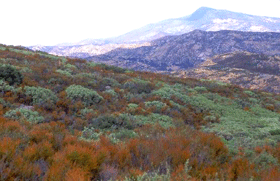
Fall in the chaparral occurs during the first few weeks of "summer." The reddish-brown hues are from the fading flower clusters on the top of the shrubs. (Photo: Richard W. Halsey)
BORCHERT: They re-sprout after a fire, but if you burn ’em again too quickly, over time they just lose the vitality, the ability to re-sprout, and then they go away. In general this would have been a much more bio-diverse plant community than the one that’s replaced it.
[FOOTSTEPS ON GRAVEL]
LOBET: Uphill in the San Bernardino National Forest is even drier chaparral.
BORCHERT: We would call it knob cone pine chaparral.
LOBET: In general, Mark Borchert says, there’s much more of this landscape left in California.
LOBET: So our kids, our grandkids, if they want to go hiking in a forest that's a chaparral forest, chances are they’re going to be able to?
BORCHERT: I think that's correct.
LOBET: But his colleague Hugh Safford is less sanguine.
SAFFORD: Let's be honest. The number of ignitions that the fire agencies put out every year is just mind-boggling. It really is.
LOBET: Both cite climate models that pretty much agree California is in for hotter, drier summers, which means more fires, or ignitions. Some officials even say fire season is now year round.
SAFFORD: The situation is this: as more and more people move into the system, it simply means more and more ignitions, and as we have, you know, drought years like we had in 2002 was a bad one. Last year was the worst one in recorded history and that kind of thing… Chaparral’s already flammable, but it's gonna set it up to be even more flammable. And add a Santa Ana wind in October and you're sort of stacking the deck now, you know, more people, more ignitions, drier summers.
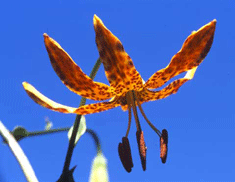
The chaparral is home to colorful wildflowers like this Humboldt’s Lily at the base of Viejas Mountain in San Diego County. (Photo: Richard W. Halsey)
SAFFORD: In the last four years, they’ve probably burned up two to three million acres of chaparral and nearly a hundred thousand acres of that were re-burned in '07 that had already burned in '03. I mean, you're talking about a hundred thousand acres of probable loss of chaparral.
[CHILDREN PLAYING; TWO SHORT BLOWS ON WHISTLE]
TEACHER: Room 17, come forward.
[BIRD SONG]
HALSEY: Hello, little friends. My name’s Mr. Halsey. You can call me Rick, otherwise known as the Voice of the Chaparral.
LOBET: One man who watched those 100,000 acres in San Diego burn twice in five years has now made chaparral his life's work. Today Rick Halsey is out in the sweet smelling hills with a class of fourth graders.
HALSEY: First of all I have to say something, I have to say something. I have been with adults for like two weeks. Ewwugh – so glad I’m with kids today.
LOBET: Halsey is a former biology teacher. He warms the kids up teaching them the birdcall for the wrentit. They're so engaged they hardly laugh at the name.
[HALSEY WHISTLES BIRD CALL; KIDS IMITATE HIM]
HALSEY: Oh, you could get a boyfriend or girlfriend any day!
[KIDS LAUGH; SAY EWW]
Halsey: That’s how they do it, you know. When birds sing, they're usually looking for a boy or girlfriend, or they're telling the guy next door: "Get out of my territory!" That’s what they’re saying usually.
LOBET: Then comes the name for the hillside plants these San Diego County kids have seen their whole lives.
HALSEY: Chaparral!
HALSEY AND KIDS: C-H-A-P-A-R-R-A-L.
HALSEY: Did you know there is more chaparral in California than any other plant community?
LOBET: Halsey says when people head into the national forests, they're looking for pine trees and have a sort of 'are we there yet?' attitude toward the plants that make up the majority of their native ecosystem. Or worse, see them as a weedy fire hazard that has to be cleared.
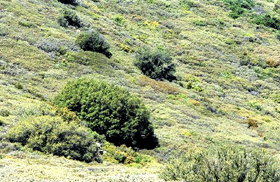
A dense carpet of 8-foot-tall old growth manzanita and scrub oak chaparral in Guatay Mountain, San Diego County. (Photo: Richard W. Halsey)
LOBET: Halsey would like the four national forests of southern California to be renamed National Chaparral Recreation Areas, because he says people just can't appreciate chaparral when they're looking for trees.
HALSEY: And when you don't know something exists ’cause it doesn't have a name, it has a tendency to be exploited, and it can disappear without anybody knowing it ever was there.
LOBET: When talk turns to the San Bernardino National Forest, even Halsey sounds like hope is scarce.
HALSEY: Well, the San Bernardino Forest – the front country it’s called – it's pretty devastated. And I don't see much that can be done to change that, because the fire frequency is so high. Some of those areas burn every year.
LOBET: On the other hand, he says, devastated lands can be turned around when communities adopt them, yanking out grasses and replanting. Also, as new homes crowd their way up the skirts of the mountains, developers could build in blue green spaces, where new residents could walk among native plants, instead of palm trees.
HALSEY: And then all of a sudden, they start smelling the sage and the sumac. And they get connected with it. And they get this feeling when they walk out in the morning with their coffee, and they can smell the air with these fragrances that have been here for millions of years.
[KIDS TALKING; HALSEY: SMELL, SMELL, SMELL, SMELL, SMELL, SMELL, SMELL!]
LOBET: Halsey waves a sprig of white sage by the fourth graders in hopes of making some primal connection.
[HALSEY: SMELL, SMELL, SMELL, SMELL, SMELL, SMELL, SMELL, SMELL! KIDS: OOH AND AHH, SAY ‘YUMMY!’ ‘CANDY!’; HALSEY SAYS, ‘DID YOU SMELL IT?’ KIDS SAY ‘YEAH’]
LOBET: Perhaps the cure for a devastated landscape germinated here today. For Living on Earth, I'm Ingrid Lobet.
HALSEY: Oh it’s a phainopepla! You see that bird up in that tree? He had these little white wing bars on there? He was catching a little moth. Okay, anyway, I’m getting distracted.
Links
Living on Earth wants to hear from you!
Living on Earth
62 Calef Highway, Suite 212
Lee, NH 03861
Telephone: 617-287-4121
E-mail: comments@loe.org
Newsletter [Click here]
Donate to Living on Earth!
Living on Earth is an independent media program and relies entirely on contributions from listeners and institutions supporting public service. Please donate now to preserve an independent environmental voice.
NewsletterLiving on Earth offers a weekly delivery of the show's rundown to your mailbox. Sign up for our newsletter today!
 Sailors For The Sea: Be the change you want to sea.
Sailors For The Sea: Be the change you want to sea.
 The Grantham Foundation for the Protection of the Environment: Committed to protecting and improving the health of the global environment.
The Grantham Foundation for the Protection of the Environment: Committed to protecting and improving the health of the global environment.
 Contribute to Living on Earth and receive, as our gift to you, an archival print of one of Mark Seth Lender's extraordinary wildlife photographs. Follow the link to see Mark's current collection of photographs.
Contribute to Living on Earth and receive, as our gift to you, an archival print of one of Mark Seth Lender's extraordinary wildlife photographs. Follow the link to see Mark's current collection of photographs.
 Buy a signed copy of Mark Seth Lender's book Smeagull the Seagull & support Living on Earth
Buy a signed copy of Mark Seth Lender's book Smeagull the Seagull & support Living on Earth

